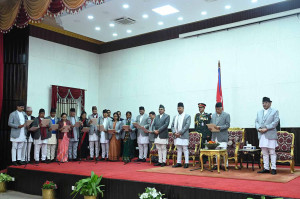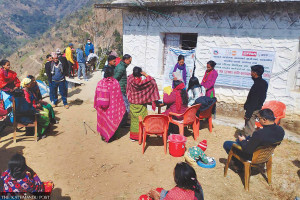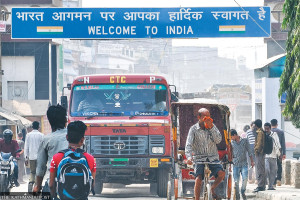 16.12°C Kathmandu
16.12°C KathmanduNational
Conjunctivitis spreading fast hinting at national outbreak
Doctor at Janaki Eye Hospital in Janakpur says around 1,000 patients have been visiting the hospital daily.
Ramesh Chandra Adhikari & Shyam Sundar Shashi
Conjunctivitis, also called pink eye disease, has been fast spreading in districts across the country. The past few weeks have seen a rise in conjunctivitis cases in all seven provinces.
According to health experts, conjunctivitis cases are usually reported between the months of March and August in Nepal in limited numbers, but this year the disease started spreading fast in local communities in the last two weeks.
Rajkumar Gurung, chairman of Nepal Netra Jyoti Sangh in Taplejung, said incessant rainfall, floods, and increased moisture in the air have fueled the spread of the diseases this year.
“Rise in humidity and contamination of water leads to the spread of conjunctivitis,” Gurung said. “It generally affects children more than adults and also people with low immunity, as they are the most vulnerable.”
Conjunctivitis is a communicable disease that causes inflammation of the conjunctiva, which is the thin layer of tissue on the inside of the eyelids. It can be caused by a viral or bacterial infection. Viral infections typically have a watery discharge, while bacterial infections have a yellowish discharge. Similarly, there are also allergic, toxic, and nonspecific types of conjunctivitis.
The infection usually lasts for a week but if not treated in time, further infection may occur and damage parts of the eyes permanently, according to health experts. The symptoms of conjunctivitis are a pink or red colour in the white of the eyes, swelling of the insides and outsides of the eyes, and a continued urge to rub the eye with a heavy increase in tear production. Also, illness, including a runny nose, cough, sore throat, and fever, among other conditions, can be seen after one is infected by the disease.
Kaji Gurung, in charge of Dechan Dongala Eye Care Centre in Phungling Municipality, says cross-infection can still occur until one week after the disease is cured in one person. “One should pay special attention to cleanliness after getting infected. Infected people should always wash their eyes with clean water, avoid any kind of physical contact with others, and only clean their eyes using clean handkerchiefs,” said Gurung.
“Around 45 patients infected with conjunctivitis come seeking treatment at the centre daily,” he said. “But since there are only two eye care centres in Taplejung and that too in urban centres, we haven’t been able to gather much data from rural areas. Most of our patients are from Phungling Municipality and surrounding areas. Conjunctivitis cases are being reported from rural areas of the district too but we haven’t been able to dispatch a health team there due to geographical difficulties and bad weather conditions.”
In Madhesh Province, the provincial Ministry of Health and Population has started collecting data on conjunctivitis patients through eye care centres and hospitals in all eight districts of the province.
According to Ophthalmologist Dr Amit Kumar Yadav of Janaki Eye Hospital in Janakpur, around 1,000 patients from several districts of the province have been visiting the hospital daily. Among them, around 45 percent are suffering from conjunctivitis. “Until two weeks ago, we had only 10 to 15 conjunctivitis patients visiting the hospital on a daily basis,” said Yadav. “Last year, we received only five to 10 patients in a span of a week in March-April, but this year the number has increased.”
According to him, the hospital plans to conduct an awareness campaign in coordination with the provincial health ministry to control the spread of the infection. “If immediate steps aren’t taken, conjunctivitis can turn into an epidemic.”
Dr Pramod Kumar Yadav, Health Secretary of Madhesh Province, said that the ministry has distributed 1 million Ciprofloxacin drops to various eye care centres in the province. “We are planning an awareness campaign also so that the public is aware of the spread of the disease,” said Pramod.
Sindhuli in Bagmati Province has also reported a surge in conjunctivitis patients. According to Bimal Shrestha, manager of Sindhuli Hospital, around 200 to 300 patients infected with conjunctivitis have been visiting the hospital daily. “Children are the most affected by conjunctivitis. Most schools in the district have closed down for at least a week starting from Monday to avoid the spread of conjunctivitis in schools,” said Shrestha.
Kamalamai Municipality in Sindhuli decided to close schools for five days due to an outbreak of the eye disease, according to Mayor Upendra Kumar Pokharel. “We have no alternative to closing classes for a few days after many students, teachers and staff members contracted the disease,” Pokharel told the Post on Sunday.
The number of conjunctivitis patients has also increased in Gorkha district in the last one week.
According to the Gorkha Lions Service Centre, 60 percent of those who came for an eye examination are suffering from the disease. The centre said the number of patients coming for eye treatment at the health facility in Gorkha Municipality-6 has also increased in the last one week.
Bishwa Prakash Aryal, administrative officer at the centre, said that out of 493 people who came to the centre for an eye examination, 295 people were diagnosed with viral conjunctivitis.
Aryal informed that patients come for treatment with problems such as pink or red eyes, swelling of the insides and outsides of the eyelids, itchy and watery eyes, runny nose, cough, sore throat, and fever, among others.
The centre also informed that among those visiting the medical facility, most of them are children as the disease generally affects children.
In Chitwan, three local units have decided to shut down schools following an outbreak of viral conjunctivitis.
Bharatpur Metropolitan City Education Officer Mahendra Prasad Paudel informed that all educational institutions in the metropolis will be closed from Monday to Friday owing to the spread of the disease.
Similarly, educational institutions in Ratnanagar Municipality will also be closed from Monday to Wednesday, according to Education Officer Badri Narayan Sharma.
Khairhani Municipality, which had issued a notice on Friday to close schools in the area until Monday, has extended the closure by two more days until Wednesday since the disease is yet to come under control, said municipal Education Officer Raju Baniya.
According to Ram KC, the information officer at the Chitwan district health office, the outbreak of the viral disease in Khairhani started last week.
KC informed that the number of patients suffering from eye-related problems has doubled at the Bharatpur Eye Hospital.
A total of 2,357 people came to the main hospital and other auxiliary centres and units on Sunday, said Daya Shankar Chaudhary, senior administrator of the hospital.
“More than 60 percent of them are suffering from the viral infection,” said Chaudhary. “The health office has appealed to the general public to take precautions as the infection of the disease may increase.
In Lumbini Province too, several schools have closed for a week given the rise in conjunctivitis cases in students. According to Shalikram Gautam, an ophthalmologist at the Rapti Eye Hospital, around 700 patients visit the hospital daily, and among them, nearly 50 percent are infected with conjunctivitis. Similarly, according to the data from Dang-based Lamahi Eye Hospital, around 150 conjunctivitis patients have been visiting the hospital on a daily basis.
Siriya Rural Municipality in Rupandehi, Pratappur Rural Municipality in West Nawalparasi and Gautam Rural Municipality in Dang have closed all the schools for one week after an increase in conjunctivitis patients in the school.
“Even the Dang District Prison has reported an outbreak of conjunctivitis. Around 50 inmates of the prison were found to be infected by this disease on Monday,” said Gautam. “Poor sanitation on the prison premises might accelerate the spread of the infection.”
In Salyan of the Karnali Province, 80 percent of the 103 people who visited the Sitalpati Eye Treatment Centre on Sunday were infected with conjunctivitis, according to Nabina Chaudhary, in charge of the centre. “Around 40 to 50 people used to visit the centre on a normal day, but on Sunday the number doubled. Half of those who came for treatment were conjunctivitis patients,” she said.
According to the health workers of District Hospital Salyan, most of the infected people are from the urban areas of the district.
In Sudurpaschim Province, Kailali and Kanchanpur districts reported conjunctivitis about a month ago. Geta Eye Hospital in Dhangadhi started receiving conjunctivitis patients a month ago, according to Dr Suresh Raj Pant, head of Geta Eye Hospital. Among the 400 patients visiting the hospital every day, 200 are conjunctivitis patients, said Pant.
“Among the infected, most are children under the age of 15 and elderly people from Kailali and the neighbouring district of Kanchanpur. Conjunctivitis is not unusual in this season, but this year there has been a sharp rise in the number of patients,” said Pant.
According to the data of Dhangadhi Netralaya in Dhangadhi, almost 300 patients visit the eye care centre every day, and among them, nearly 100 patients are infected with conjunctivitis.
“If we don’t take preventive measures right away, I’m afraid we may see a major outbreak of the disease,” said Pant.
Ananda Gautam in Taplejung, Raj Kumar Karki in Sindhuli, Ramesh Kumar Paudel in Chitwan, Hari Ram Uprety in Gorkha, Sanju Poudel in Rupandehi, Biplab Maharjan in Salyan and Arjun Sah in Dhangadi contributed reporting.




.jpg)
















